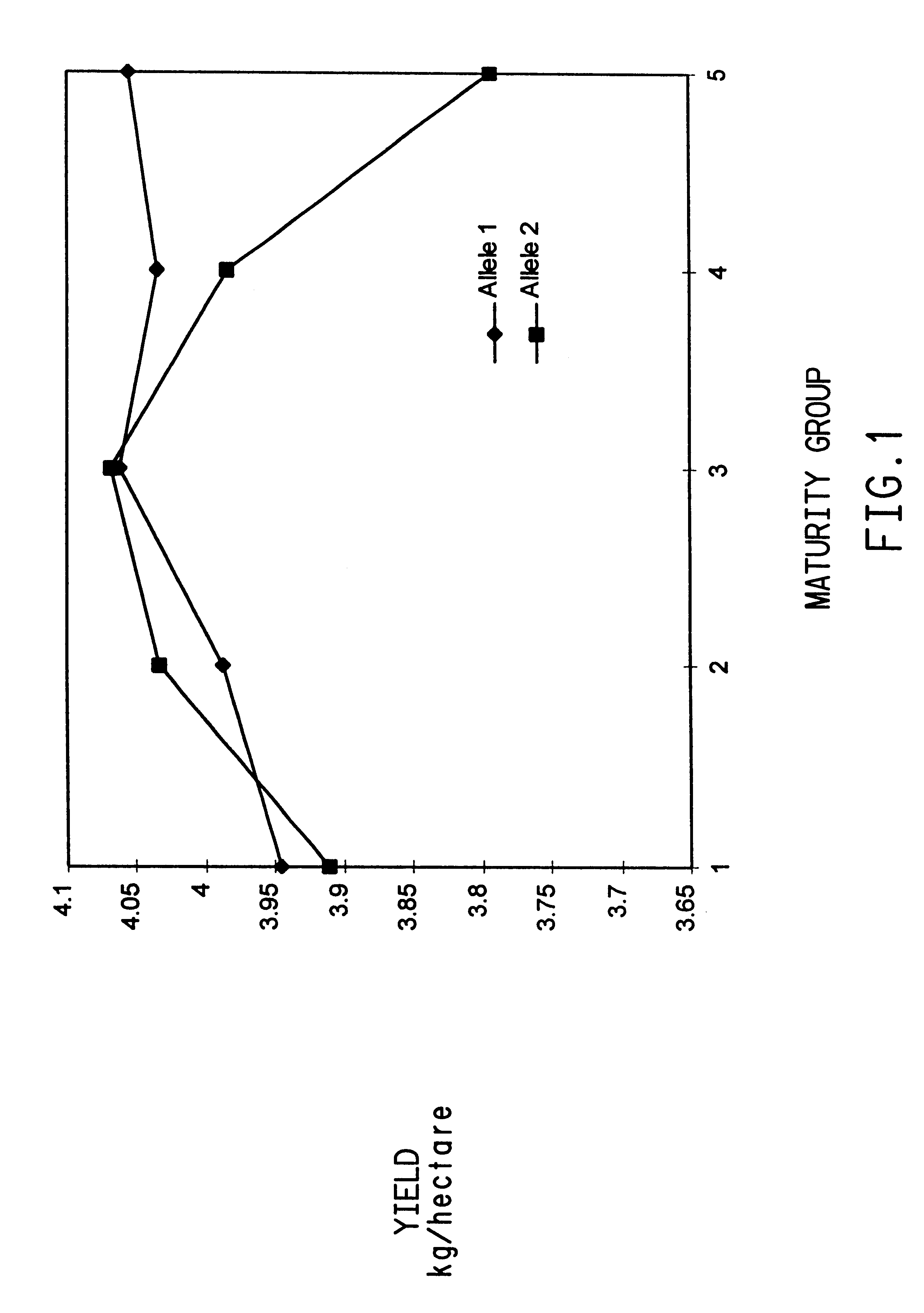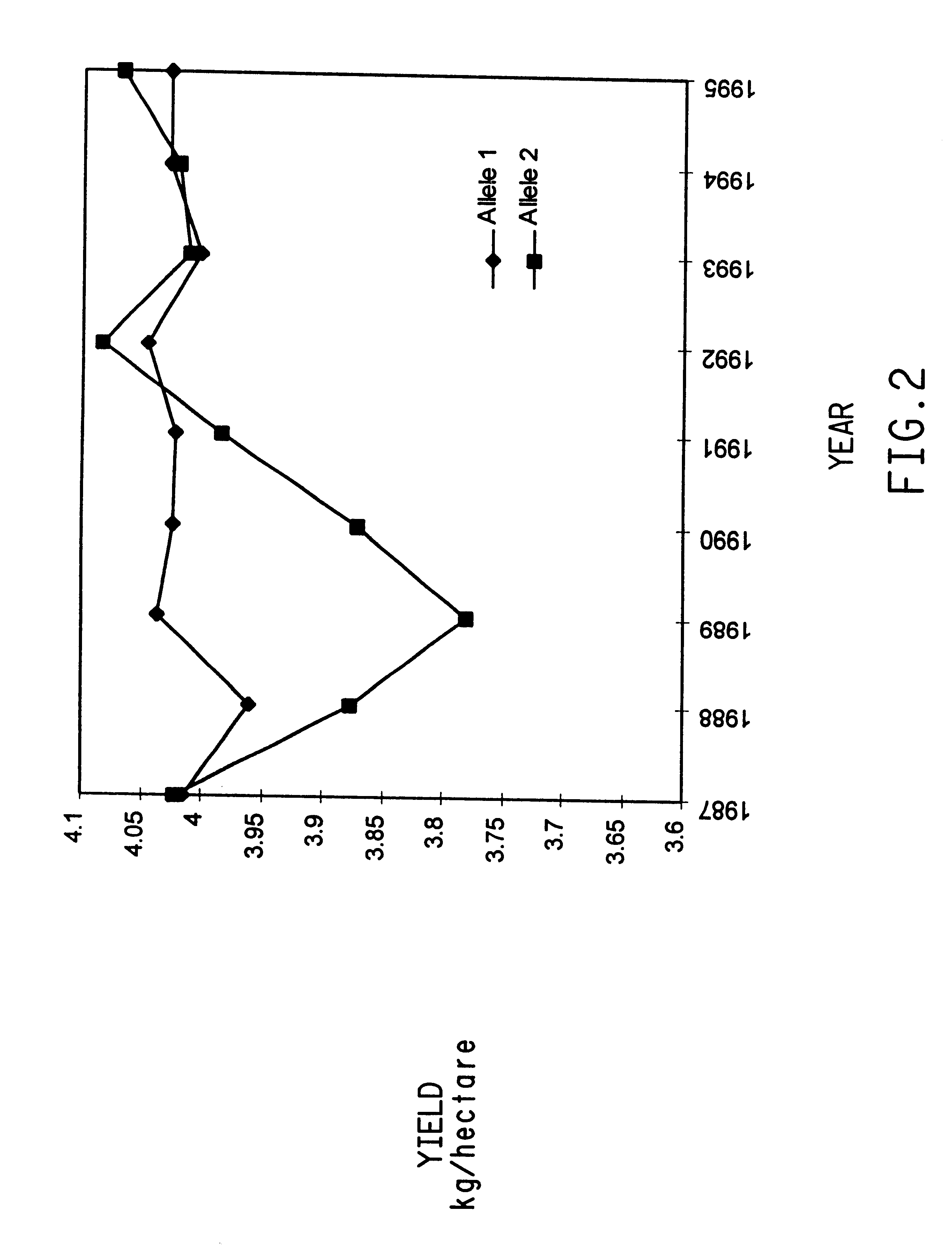Method for identifying genetic marker loci associated with trait loci
- Summary
- Abstract
- Description
- Claims
- Application Information
AI Technical Summary
Benefits of technology
Problems solved by technology
Method used
Image
Examples
example i
Identification of Trait Loci with Alleles Conferring Superior Yield Performance in Soybean
Genotypic germplasm survey development
A total of 314 soybean (Glycine max) varieties, plant introductions (PIs), and breeding lines were surveyed using 16 RFLP probes. These probes, found in Table I, were previously deposited at the American Type Culture Collection (ATCC), Manassas, Va.
Soybean leaf tissue was collected from greenhouse-grown plants and used as a DNA source. RFLP analysis was carried out as described in U.S. Pat. No. 5,437,697.
Each marker locus was scored independently and a genotypic code was assigned to each genetic marker allele class (Table II; separate marker allele classes are comprised of restriction fragments of equivalent length). Heterozygous classes were assigned using additional codes. Therefore entries with the same genotypic code at a locus shared the same RFLP pattern and were considered to be genetically identical at that locus (Table II).
Yield data collection
The ...
example ii
Identification of Trait Loci with Alleles Conferring Superior Soybean Yield Performance in Specific Environments
The yield performance of soybean varieties is highly dependent upon the environment in which those soybean varieties are grown. Depending upon the genetic composition of the soybean plants, soybeans may respond either favorably or unfavorably to the environment in which they are grown. This interaction of genotype with environment has resulted in the breeding of soybeans specifically adapted to different environments. These environments include abiotic stresses like drought or geographic changes which affect soybean maturity requirements. Because of the importance in breeding soybeans specifically adapted to different environments, it would be of value to identify those genetic marker alleles which predict superior performance in specific environments.
Identification of genetic marker alleles which predict superior yield in specific environments examination of model interac...
example iii
Identification of Trait Loci Controlling Plant Height in Soybean
The instant method is well suited to the analysis of many traits of interest in breeding. One such trait in soybean is plant height. Using the same genotypic germplasm survey described in Example I and height data collected in the very same test plots as described in Example I, an analysis of marker loci was conducted to determine which marker loci were associated with and predictive of soybean plant height. As with yield in Example I, each marker locus was tested in separate least squares analyses.
The following analysis of variance model was used to analyze each genetic marker locus:
Y.sub.ijkl =.mu.+.alpha..sub.i +.tau..sub.j +.rho..sub.k +.beta.(X.sub.ij -X . . . )+(.alpha..tau.).sub.ij +(.alpha..rho.).sub.ik +(.alpha..tau..rho.).sub.ijk +.epsilon..sub.ijkl
where:
Y.sub.ijkl =height of the ijkl.sup.th entry;
.mu.=overall mean;
.alpha..sub.i =marker allele effects;
.tau..sub.j =year effects;
.rho..sub.k =maturity effects;
.be...
PUM
| Property | Measurement | Unit |
|---|---|---|
| Fraction | aaaaa | aaaaa |
| Fraction | aaaaa | aaaaa |
| Fraction | aaaaa | aaaaa |
Abstract
Description
Claims
Application Information
 Login to View More
Login to View More - R&D
- Intellectual Property
- Life Sciences
- Materials
- Tech Scout
- Unparalleled Data Quality
- Higher Quality Content
- 60% Fewer Hallucinations
Browse by: Latest US Patents, China's latest patents, Technical Efficacy Thesaurus, Application Domain, Technology Topic, Popular Technical Reports.
© 2025 PatSnap. All rights reserved.Legal|Privacy policy|Modern Slavery Act Transparency Statement|Sitemap|About US| Contact US: help@patsnap.com


